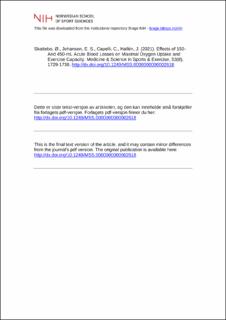| dc.contributor.author | Skattebo, Øyvind | |
| dc.contributor.author | Johansen, Espen Spro | |
| dc.contributor.author | Capelli, Carlo | |
| dc.contributor.author | Hallén, Jostein | |
| dc.date.accessioned | 2022-09-14T10:09:28Z | |
| dc.date.available | 2022-09-14T10:09:28Z | |
| dc.date.created | 2021-08-06T09:28:23Z | |
| dc.date.issued | 2021 | |
| dc.identifier.citation | Medicine & Science in Sports & Exercise. 2021, 53(8), 1729-1738. | en_US |
| dc.identifier.issn | 0195-9131 | |
| dc.identifier.uri | https://hdl.handle.net/11250/3017763 | |
| dc.description | I Brage finner du siste tekst-versjon av artikkelen, og den kan inneholde ubetydelige forskjeller fra forlagets pdf-versjon. Forlagets pdf-versjon finner du på journals.lww.com / In Brage you'll find the final text version of the article, and it may contain insignificant differences from the journal's pdf version. The definitive version is available at journals.lww.com. | en_US |
| dc.description.abstract | Purpose: This study investigated whether maximal oxygen uptake (V˙O2max) and exercise capacity are affected by small acute blood loss (150 mL) and elucidated compensatory mechanisms. Methods: Thirteen male subjects (V˙O2max, 63 ± 9 mL·kg−1·min−1; mean ± SD) performed incremental exercise to exhaustion on a cycle ergometer in three experimental conditions: in euvolemia (control; blood volume [BV], 6.0 ± 0.7 L) and immediately after acute BV reductions of 150 mL (BVR150mL) and 450 mL (BVR450mL). Changes in plasma volume (PV) and BV during exercise were calculated from hematocrit, hemoglobin concentration, and hemoglobin mass (carbon monoxide rebreathing). Results: The reduction in V˙O2max per milliliter of BVR was 2.5-fold larger after BVR450mL compared with BVR150mL (−0.7 ± 0.3 vs −0.3 ± 0.6 mL·min−1·mL−1, P = 0.029). V˙O2max was not significantly changed after BVR150mL (−1% ± 2%, P = 0.124) but reduced by 7% ± 3% after BVR450mL (P < 0.001) compared with control. Peak power output only decreased after BVR450mL (P < 0.001). At maximal exercise, BV was restored after BVR150mL compared with control (−50 ± 185 mL, P = 0.375) attributed to PV restoration, which was, however, insufficient in restoring BV after BVR450mL (−281 ± 184 mL, P < 0.001). The peak heart rate tended to increase (3 ± 5 bpm, P = 0.062), whereas the O2 pulse (−2 ± 1 mL per beat, P < 0.001) and vastus lateralis tissue oxygenation index (−4% ± 8% points, P = 0.080) were reduced after BVR450mL, suggesting decreased stroke volume and increased leg O2 extraction. Conclusion: The deteriorations of V˙O2max and of maximal exercise capacity accelerate with the magnitude of acute blood loss, likely because of a rapid PV restoration sufficient to establish euvolemia after a small but not after a moderate blood loss. | en_US |
| dc.language.iso | eng | en_US |
| dc.subject | blood volume | en_US |
| dc.subject | cardiac output | en_US |
| dc.subject | hemoglobin mass | en_US |
| dc.subject | maximal oxygen uptake | en_US |
| dc.subject | plasma volume | en_US |
| dc.subject | VO2 max | en_US |
| dc.title | Effects of 150- And 450-mL Acute Blood Losses on Maximal Oxygen Uptake and Exercise Capacity | en_US |
| dc.title.alternative | Effects of 150- And 450-mL Acute Blood Losses on Maximal Oxygen Uptake and Exercise Capacity | en_US |
| dc.type | Peer reviewed | en_US |
| dc.type | Journal article | en_US |
| dc.description.version | acceptedVersion | en_US |
| dc.source.pagenumber | 1729-1738 | en_US |
| dc.source.volume | 53 | en_US |
| dc.source.journal | Medicine & Science in Sports & Exercise | en_US |
| dc.source.issue | 8 | en_US |
| dc.identifier.doi | 10.1249/MSS.0000000000002618 | |
| dc.identifier.cristin | 1924305 | |
| dc.description.localcode | Institutt for fysisk prestasjonsevne / Department of Physical Performance | en_US |
| cristin.ispublished | true | |
| cristin.fulltext | postprint | |
| cristin.qualitycode | 2 | |
